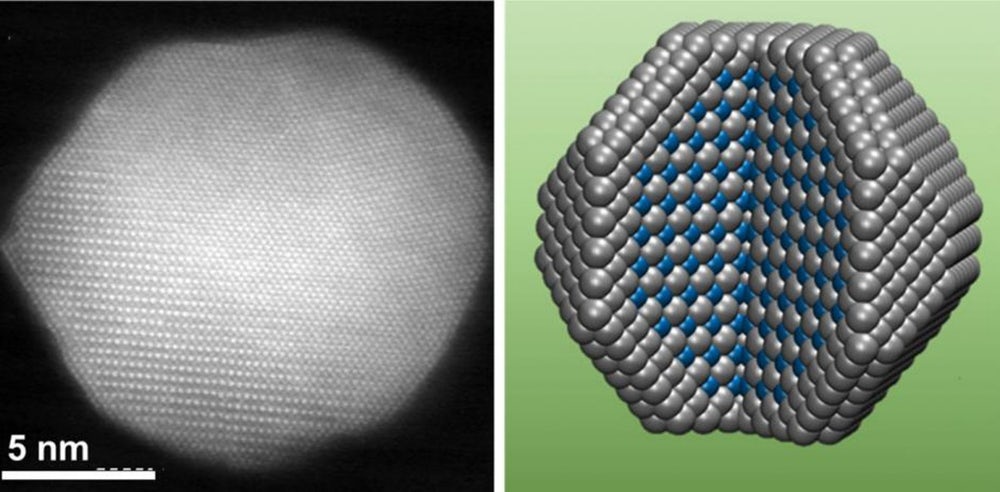A team of Brown University
scientists has developed a new catalyst that could make hydrogen fuel
cell-powered vehicles more economical. Based on nanoparticles made of an alloy
of platinum and cobalt, the new catalyst is not only cheaper than pure
platinum, but is also more efficient and longer lasting.

The new catalyst combines an outer shell of platinum atoms (gray spheres) with ordered layers of platinum and cobalt atoms (blue spheres) in its core(Credit: Sun lab/Brown University)
Hydrogen fuel cells hold the promise of vehicles that, with the proper infrastructure, combine the eco-friendliness of electric cars with the range and freedom of conventional fossil fuels. However, for fuel cells to work, they need a catalyst to facilitate the critical oxygen reduction reaction.
Fuel cells contain a proton exchange membrane (PEM) with hydrogen on one side and air containing oxygen on the other. Electrons are stripped from the hydrogen atoms and taken up by the oxygen atoms in what is called the oxygen reduction reaction to generate electricity. The problem is, for the reaction to work, a catalyst is needed. Otherwise, the energy hurdle is too great.
Platinum is the go-to catalyst, but the element is expensive, not very efficient, and is prone to "poisoning" where impurities latch onto the platinum molecules, preventing reactions. According to team leader Junrui Li, alloying platinum with metals like cobalt is cheaper and makes the catalyst more efficient, but the base metal quickly oxidizes inside the harsh conditions of the fuel cell and leeches away.
To prevent this, the Brown team created nanoparticles consisting of an outer layer of pure platinum and an interior built up of alternating layers of platinum and cobalt atoms.
"The layered arrangement of atoms in the core helps to smooth and tighten platinum lattice in the outer shell," says says Shouheng Sun, professor of chemistry. "That increases the reactivity of the platinum and at the same time protects the cobalt atoms from being eaten away during a reaction. That's why these particles perform so much better than alloy particles with random arrangements of metal atoms."
Tests of the new catalytic nanoparticles show that they already out-perform platinum and remained active after 30,000 voltage cycles – a point at which platinum drops off radically. However, the team stresses that what happens on a lab bench is different from what happens inside a fuel cell with its greater temperature and acidity. The new catalyst was therefore sent to the Los Alamos National Lab for further testing inside an actual cell.
The team says that the tests indicate that the new catalyst exceeds the targets set by the US Department of Energy (DOE) for both initial activity and longer-term durability, with an initial activity of 0.56 amps per milligram and an activity after 30,000 cycles (roughly equivalent of five-years inside a fuel cell) of 0.45 amps.
"Even after 30,000 cycles, our catalyst still exceeded the DOE target for initial activity," says Sun. "That kind of performance in a real-world fuel cell environment is really promising."
Work continues on the catalyst, which is already the subject of a provisional patent application.

 Previous page
Previous page Back to top
Back to top







